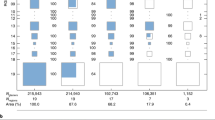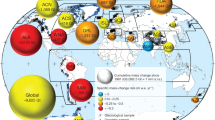Abstract
A seasonally and regionally differentiated glacier model is used to estimate the contribution that glaciers are likely to make to global sea level rise over a period of 70 years. A high resolution general circulation model (ECHAM4 T106) is used to estimate temperature and precipitation changes for a doubled CO2 climate and serves as input for the glacier model. Volume-area relations are used to take into account the reduction of glacier area resulting from greenhouse warming. Each glacieriated region has a specified glacier size distribution, defined by the number of glaciers in a size class and a mean area. Changes in glacier volume are calculated by a precipitation dependent mass balance sensitivity. The model predicts a global sea level rise of 57 mm over a period of 70 years. This corresponds to a sensitivity of 0.86 mm yr−1K−1. Assuming a constant glacier area as done in earlier work leads to an overestimation of 19% for the contribution to sea level rise.
Similar content being viewed by others
Author information
Authors and Affiliations
Additional information
Received: 16 August 2000 / Accepted: 21 May 2001
Rights and permissions
About this article
Cite this article
Van de Wal, R., Wild, M. Modelling the response of glaciers to climate change by applying volume-area scaling in combination with a high resolution GCM. Climate Dynamics 18, 359–366 (2001). https://doi.org/10.1007/s003820100184
Issue Date:
DOI: https://doi.org/10.1007/s003820100184




